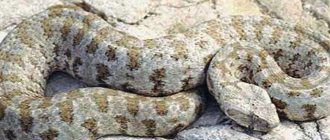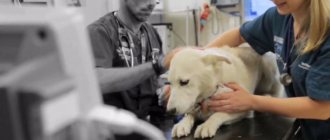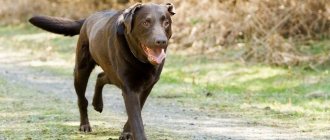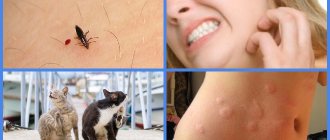Stinging insects pose a danger not only to people, but also to their four-legged pets. If a dog is stung by a bee, it may also develop an allergy. If angioedema or suffocation occurs, the injured pet must be given first aid and urgently taken to a veterinarian. Otherwise, he risks dying from the injected poison.
How dangerous is a bee sting for a dog?
Not all dog owners know how much harm a wasp or bee sting can cause to their pet. In fact, such an incident cannot be ignored: after all, dogs, like people, can become allergic to insect venom. This allergy comes in one of two types:
- congenital (the reaction occurs after the first bite);
- acquired (develops with repeated bites).
Any dog breeder needs to know that a certain percentage of dogs, due to an allergy to bee venom, experience anaphylactic shock, which can lead to swelling of the larynx, and as a result, difficulty breathing and even death of the animal. Especially dangerous are numerous insect bites that occur, for example, when a dog destroys a wasp nest, as well as situations in which the dog was stung in the face, lip or tongue. If this happens, it is recommended to take the dog to the veterinarian as soon as possible.
However, there is no need to panic: although most dogs react painfully to insect bites, this does not cause serious harm to health provided that assistance is provided competently and the pet is closely monitored.
Prevention
We looked at the symptoms, treatment and prevention if your dog is stung by a wasp or bee. Is there any way to protect your pets from stinging insects? This cannot be done completely. But you can minimize the risks.
You should keep an eye on your pet while walking. Keep it away from flowering plants and berry bushes. This is especially true for active breeds. After all, you can often meet, for example, a curious dachshund that was stung by a bee while out for a walk. But a calmly walking French bulldog rarely becomes a victim of stinging insects.
The walking area should be checked for wasp nests. By following these rules, the number of bites will be kept to a minimum. The dog owner must have a first aid kit containing the medications necessary to provide medical care.
Bite symptoms
How can you tell if your dog has been bitten in order to take timely action? If this did not happen before your eyes, pay attention to the following signs:
- if a bee bites a dog on the paw, the dog whines, gnaws or licks its claws and fingertips - this is caused by pain and itching at the site of the bite;
- if the muzzle is injured, the dog may howl, whine, and rub the bitten area with its paws.
Swelling, lethargy, increased salivation, and difficulty breathing may also occur.
Photos of dogs stung on the nose by bees
Sources
- https://Ros-Vet.ru/koshki/esli-sobaku-pokusala-osa-pervaya-pomoshh/
- https://dezbox.ru/dezinsekciya/chto-delat-esli-sobaku-ukusila-osa/
- https://porodadog.ru/zdorove/prochie-bolezni/sobaku-ukusila-pchela.html
- https://www.pitomec.ru/articles/dogs/health/541
- https://gafki.ru/sobaki/ukusila-osa-v-lapu-ili-mordu.html
- https://ilike.pet/ru/articles/moego-psa-uzhalila-osa-chto-delat-_19/
- https://pesikmal.ru/zdorove/bolezni/pchela.html
[collapse]
First aid
In the event of a bite, behave calmly, do not panic or scold the dog under any circumstances: after all, the dog is already stressed from pain and surprise. Take the following actions as soon as possible:
- Pull out the sting if there is one.
Insects sting in different ways: for example, a sting remains at the site of a bee sting; wasps, bumblebees and hornets do not leave it. Therefore, if a dog is bitten by a bee, the sting must be removed immediately. This can be done using tweezers, nails, nail scissors, or a handy tool such as a plastic card. There is a sac with poison on the bee sting, so it must be pulled out carefully, using sliding movements, so that the remaining toxic substance is not squeezed out and does not enter the animal’s blood. - Treat the stung area.
Apply a gauze or cotton swab soaked with water and ammonia to the dog's paw, nose or lip. The bite can also be washed with alcohol or even regular vodka. If you don’t have anything like this on hand, just rinse with water. - Apply a cold compress.
Cold helps reduce swelling, reduce pain and slow down the absorption of bee venom. Do not keep the ice pack on for more than 15 minutes. During all these manipulations, talk to the dog and calm it with your voice. - Use folk remedies.
the cous can be treated with grated parsley leaves, dandelion juice, plantain or honey. - In case of numerous bites, provide the dog with plenty of fluids
- this will help the toxic substances leave the dog’s body faster. - Lubricate the wound with an anti-allergic ointment that relieves itching
. This is important because, as any dog lover knows, a dog can easily scratch an itchy bee sting and cause an infection. As such a remedy, you can use fenistil, lorinden, one percent hydrocortisone ointment, etc. - Give your dog an antihistamine.
One tablet of suprastin, loratadine, diphenhydramine or tavegil will be enough.
As a rule, these measures are sufficient for a bite on the paw. During the first time after a bite, observe the dog as carefully as possible in order to promptly notice the manifestation of an acute allergy to the bite of a poisonous insect.
Treatment and relief of edema
Was your dog bitten by a wasp? There is a high probability of developing inflammation and swelling. Swelling may appear immediately after the poison enters the body, or over the next 2-3 hours. To eliminate the condition, medications and folk remedies are used.
Pills
Animals with edema that have been bitten by insects are prescribed the following medications:
| Name | Release form | Dosage |
| Prednisolone (steroid hormone) | 5 mg tablets | 0.5-1 mg per 1 kg of weight (every 12 hours) |
| Fenkarol | tablets 10 mg, 25 mg | 10-15mg /2 times a day |
| Clemastine | 1 mg tablets | 0.05-0.1 mg/kg (every 12 hours) |
| Medrol(methylpred) | 5 mg tablets | 0.4-0.8 mg/kg |
| Zodak (cetirizine) | 10 mg tablets | 1 mg/kg (interval – 24 hours) |
Medicines are convenient to use. Before use, they must be crushed and turned into powder . Dosage for treatment should be discussed with your veterinarian during an in-person visit or by telephone.
If a dog that has been bitten by stinging insects develops swelling, doctors recommend using diuretics. For example, Lasix, torsemide, veroshpiron, hypothiazide. In this case, it is necessary to provide the animal with plenty of fluids .
Ointments
What else needs to be done for swelling if the dog has been bitten by bees or wasps? Use anti-inflammatory, analgesic ointment Indovazin . It should be used together with the drug Famotidine , a gastrointestinal protector.
Dexamethasone ointment, which has antiallergic and decongestant properties, effectively helps against bites. It will relieve a dog that was bitten by insects while walking from pain, swelling, itching, and hives.
Glucocorticoid ointments show high effectiveness in treatment: elocom, advantate . They are also available in the form of cream and suspension. They are hormonal drugs. Relieves inflammation, swelling, reduces tissue susceptibility to allergens.
Typically, ointments are applied 2 times a day (morning and evening) until the swelling subsides. Any medications can cause allergies. If it occurs, you should stop using the drug and consult a veterinarian.
Traditional methods
What to do if an insect bites a dog, but there is no way to use pharmacological agents? Minor swelling, inflammation, and itching can be completely dealt with using traditional methods, using the healing properties of plants.
- Aloe vera . The juice of this succulent has been used for centuries to treat skin diseases. It relieves swelling and inflammation. Relieves rashes and severe itching. If a puppy or adult dog is bitten by a wasp while walking, you can apply the pulp of the plant to the sore spot.
- Echinacea . Dogs that have been bitten by bees or wasps in the summer are given a lotion with a decoction of this plant. Echinacea is a natural antiseptic and antiviral agent. Effectively helps with symptoms of snake bites.
- Pharmaceutical camomile . The plant heals wounds, reduces inflammation and swelling in pets. Medicinal decoctions are prepared from chamomile, which are used for compresses on the bite site.
- Plantain . It is a kind of ambulance. Owners remember it as soon as the question arises: what to do if a dog was bitten by a wasp or a bee while walking. A leaf of the plant can be applied to the wound, kneading it in your hands to release the juice.
- Bulb onions . You can apply half of the whole head to the affected area, cut side down. Another way is to chop the onion using a knife or blender. Apply the resulting pulp to the bite site through gauze so as not to cause a skin burn.
Herbal lotions are good for wasp bites. They may include, in addition to the above plants, calendula, comfrey leaves and roots, mint, lemon balm, parsley, dandelion. You can enhance the effect with honey. It will help draw out the poison that remains after removing the insect sting from the wound.
“Green healers” are used to prepare healing infusions for allergies. 1 tbsp. l. dry raw materials are poured with a glass of water, put on fire and boil for 3-5 minutes. The resulting product is given to the animal 30-50 ml with each meal. For these purposes, nettles, wild rosemary, yarrow, oak bark, blueberries, and cinquefoil are used.
The owner should be aware that herbal infusions and teas may taste bitter. Getting your pet to drink them for treatment is quite difficult. What to do? Sweeten the resulting infusion with dextrose or glucose to make it pleasant to drink. For internal use, you can use dry herb. It is recommended to finely chop it and mix it with meat or minced meat.
Traditional methods of treatment must be coordinated with a veterinarian. Many plants, if used incorrectly, can cause harm to animals. Only a doctor knows what to do and how to use them correctly if a four-legged friend is bitten by a bee.
What to do in case of an acute allergic reaction
If the dog has been stung for the first time, the risk of allergies is less than with subsequent bites. The following symptoms indicate that the consequences for the dog were much more serious than usual:
- heavy or difficult breathing;
- severe swelling of the stung area;
- foam from the mouth;
- vomit;
- tongue color changes to purple;
- loss of consciousness.
In this situation, you need to immediately give an injection of an antihistamine and urgently take the dog to a veterinary clinic.
What not to do
- independently try to bring the dog out of anaphylactic shock, especially if it is accompanied by swelling of the upper respiratory tract;
- treat the bite site with alcohol-containing substances;
- give human antihistamines without consulting a veterinarian (at least by phone), because not all medications are suitable for dogs;
- do not use any essential oils, especially if the bite is on the head - an additional strong smell can increase swelling.
Antiallergic drugs
In case of a bite in the face or lip, or the onset of an acute allergy, it is necessary to give injections rather than give tablets: the latter act too slowly, and the stung area swells very quickly. Therefore, dog breeders should purchase a couple of ampoules of the following drugs so that they are always on hand in their home veterinary medicine cabinet. You should also take the ampoules with you during trips to nature - to keep them safe and sound, wrap them in foil.
- You can buy suprastin or tavegil in ampoules at the pharmacy without a prescription. Diphenhydramine is also suitable - but, unlike the previous ones, it is available with a prescription.
- Dexamethasone, also in ampoules.
In case of severe swelling, some veterinarians recommend additionally injecting the dog with a diuretic (furosemide) and magnesium.
Bitten by a wasp (bee): dangerous or not?
An insect bite is always very painful. Further developments depend directly on the dog’s immunity and tendency to express an allergic reaction. In 3-7% of cases, a wasp (bee) sting causes a severe reaction with complications, including death.
Bees rarely attack animals on their own initiative; bites are their natural defensive reaction to a dog’s “interest” in the nest or when a pet accidentally presses an insect. Bees, wasps, and bumblebees really do not like sudden movements, loud sounds, or unpleasant odors.
Dosage of drugs for acute allergies
Note! The drug for injection and its dosage should be prescribed by a specialist. Consult your veterinarian before using them. The figures below are provided for informational purposes only and for single use only – in case of long-term use, significant differences in dosage are possible.
- Suprastin, tavegil and diphenhydramine
: if the pet’s weight is less than 10 kilograms, 0.1 ml of the drug is taken for each kg. For example, with a dog weighing 8 kg, the dose is 0.8 ml. For a dog weighing from 10 to 20 kg, take 1 ml, over 20 kg - 2 ml. - Dexamethasone:
weight less than 10 kg - 0.1 ml per kilogram; from 10 to 30 kg – 1 ml; more than 30 – 2 ml. - Furosemide:
less than 10 kg - 0.1 ml per kilogram of weight, from 10 to 20 - 1 ml, more than 30 - 2 ml. - Magnesia (25 percent solution) –
0.1 ml per kilogram of weight. For example, with a weight of 10 kg - 0.1 ml, 20 kg - 2 ml, from 30 to 40 kilograms - 3 ml, from 40 to 60 - 4 ml.
How to protect your pet
In judicial practice, there have been cases when bees bit a dog, and the beekeeper compensated for the damage. During the honey harvest period, insects become aggressive, so the likelihood of getting a bite at this time increases several times. Despite this, preventing a dangerous situation is much easier than demanding moral compensation in court.
First of all, you should evaluate the environment in places where you frequently walk your dog. It is advisable to avoid being near apiaries. It is not recommended to let your pet near berry bushes. If a nest of wild bees is discovered, it is necessary to destroy it using the safest means before the insect has time to bite someone close to you. It is also important to ensure that you have a first aid kit, which you should always take with you on a walk. The life of a pet may depend on the timely provision of first aid.
Precautionary measures
Even the most attentive dog breeder is unlikely to be able to protect his pet from bites to any extent. The following recommendations will help reduce the risk:
- During walks in nature, do not let your dog near flower beds and bushes with flowers, do not let them prop up pears, apples and other fruits that have fallen from trees - all this attracts stinging insects.
- When playing with your pet, stay away from places where hymenoptera live: beehives, wasp nests, etc.
- If you find nests of insects in the area, try to get rid of them. As a rule, wasps and hornets make nests under roof eaves, in pipes, under construction boards, near reservoirs, as well as in hollows and tree stumps.
- Place wasp traps in areas where the dog and family members do not enter.
Remember the most important thing: if the dog’s condition after a bite causes concern, do not under any circumstances delay going to the veterinarian, and before taking any serious measures on your own, it is advisable to consult with him by phone.
You can also contact our site's staff veterinarian, who will respond to them as soon as possible in the comment box below.
When to urgently contact a veterinarian
The pet owner should not self-medicate in the following situations:
- If your pet is bitten by several bees or wasps at once;
- If the animal's face is injured or the dog swallows a stinging insect;
- The dog’s health deteriorated and signs of a serious allergy appeared;
- The pet was not healthy even before the bite.
Remember that a harmless bite can cause many unpleasant moments for your dog.
Therefore, try to monitor him more closely after an unpleasant situation and if his condition worsens, do not be afraid to contact a veterinarian. On our website there are more than 3420 veterinary clinics in Moscow for you on our website injections for animals











